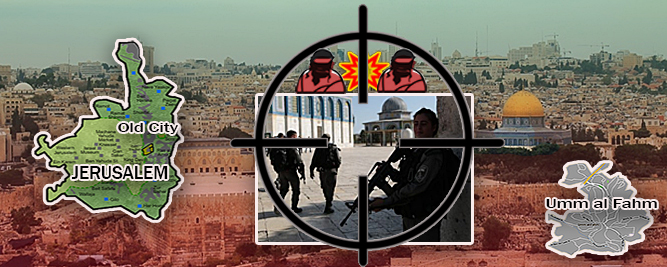
Three major Israeli counter-terror operations in a week (Aug.10-16) are a measure of the intensity of terrorist plots for the commission of mass-casualty strikes in Jerusalem.
On Aug. 10, a combined effort of the Shin Bet, the police and the IDF, led to five Palestinians from Hebron being intercepted in the Palestinian Jerusalem neighborhood of El Azaria on their way to an attack. No details of this plot were released. But it was obvious that the five terrorists, armed with guns and explosives, were only stopped at the last minute from reaching the center of Jerusalem, just 15 minutes drive from El Azaria, and conducting a major attack.
Then, on Saturday, Aug. 12, a Palestinian woman knifed a man on Suleiman Street in East Jerusalem, mistaking him for a Jew. He turned out to be a local Arab Christian and was not badly hurt, before a police patrol nabbed the woman.
On Sunday, Aug. 13, a suspect was shot in the foot while resisting arrest at Bet Tsafafa, in southern Jerusalem . The police later reported they acted on a Shin Bet tipoff that the suspect, a resident of the mixed Abu Tor neighborhood, was primed for a terror operation.
On Monday, Aug. 14, indictments were filed at the Jerusalem district court against three residents of East Jerusalem on charges of plotting a shooting attack, as well as targeting police forces and persistent rock attacks on traffic – all in Jerusalem. They were also accused of planning to loose gunfire and explosive devices on vehicles using the Nablus bypass. This group therefore harbored ambitions for a widespread terrorist offensive in and outside Jerusalem.
Although Israel’s security authorities are cagey with the information they release on the mostly covert war they wage on Palestinian and Israeli Arab terror, three geographical areas may be marked out as significant: They are metropolitan Jerusalem including Bethlehem; Hebron – the city and mountain district; and the Israeli Arab town of Umm al-Fahm, northeast of Tel Aviv, which was the home town of the three gunmen who shot dead two policemen on Temple Mount on July 14.
Each location occupies a special place on the terror map.
The terrorist networks of Hebron and its environs are mostly tied ideologically and operationally to the extremist Palestinian Hamas. In the past fortnight, Hamas was found to be receiving large sums of money, most of it coming from sources in the United Arab Republic in the Persian Gulf. Some of the cash was funneled to Judea and Samaria and provided those networks with an extra incentive to go into action.
Finding the UAE funding Hamas terror was somewhat of a shocker to Israel. After all, the emirate formally joined the anti-terror coalition that US President Donald Trump created during his visit to Riyadh and later to Israel in early April.
The terrorist cells operating in Jerusalem mostly belong to Mahmoud Abbas’ Fatah party, or its militia, the Tanzim. Most are fringe groups that are not directly associated with their leaders. But the fact that they are free to perform acts of violence against Israelis is worrying Israeli security authorities.
The networks of Umm al-Fahm and its rural villages appear to be ideologically inspired by the outlawed Northern Branch of the Israeli Arab Muslim Movement (which is linked to the Muslim Brotherhood), or directly tied to the Islamic State command center in Syria.
At least 20 Israeli Arabs are known to have crossed into Syria to fight in ISIS ranks, some of them from Umm Al-Fahm.
Last Friday, Aug. 11, an indictment was filed against two residents of the town, who were preparing to leave for Syria and join the Islamic State. They were being helped by a former resident who had already reached Syria and was fighting with ISIS. One of the accused belonged to the same Jabarin clan as the murderers of police officers on Temple Mount.
Then, on Tuesday, Aug. 15, police arrived at the Umm Al-Fahm home of Sheikh Raed Salah, leader of the banned Northern Branch of the Israeli Muslim Movement, with a warrant for his arrest. He was accused of publicly inciting to violence and terror and membership of an illegal organization.
Salah has been in and out of Israeli prisons for years over his fiery hate-filled sermons, which regularly call on his followers to “fight for the liberation” of Al Aqsa. Last year, he was locked up for calling on Israeli Arabs to join a Palestinian uprising against the state of Israel.
However, this time, the wide publicity given to his arrest so soon after the Temple Mount clashes – in an attempt to press charges serious enough to keep him behind lock and key for the long term – has brought the firebrand sheikh solid sympathy among sections of the Israeli Arab populace.
Obviously, Israel’s sovereign presence on Temple Mount, which is holy to three monotheistic faiths and claimed by Muslims, is an abidingly explosive issue. Last month’s crisis centering on the shrine, appears to have abated – but only on the face of it. The embers of the conflagration continue to simmer under the surface of the site and the city.



Leave a Reply
You must be logged in to post a comment.